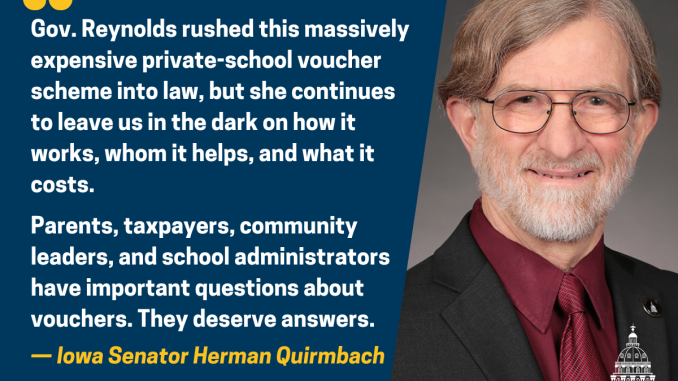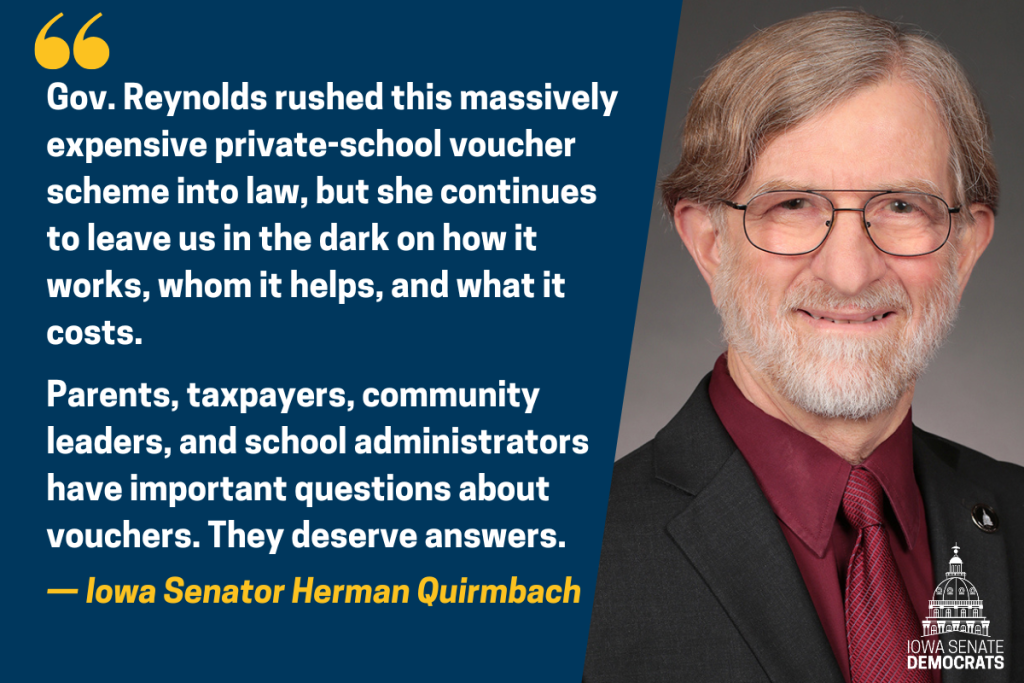

As nearly five hundred thousand Iowa K-12 students head back to school this week, Gov. Kim Reynolds and the Iowa Department of Education still owe parents and taxpayers answers to critical questions about their private-school voucher scheme.
Passed by Iowa Republican politicians just last January and outsourced to a private, out-of-state, for-profit company over the summer, the new voucher regime is about to funnel more than a hundred million dollars in public funds to exclusive private schools.
There is still much the public doesn’t know about this program. Senate Democrats are encouraging parents, taxpayers, school administrators, and journalists to raise their voices and demand answers from the Reynolds Administration on how vouchers are being implemented and how they’re impacting Iowa public schools.
Gov. Reynolds and her Department of Education still haven’t answered five key questions:
1. How many vouchers is the state handing out this year, and how much will they cost taxpayers?
Even as money is routed out of the state treasury, through a for-profit company, and into private-school bank accounts, taxpayers remain in the dark on how much they’re on the hook to pay. We know the state has approved 18,627 voucher applications – far more than initially budgeted – but we still don’t know how many recipients will actually attend private schools and what it will cost the state treasury in total.
2. How much funding is each school district losing due to vouchers?
With public school funding this school year running nearly $800 per kid behind inflation compared to seven years ago, every taxpayer dollar paid out to private schools is a dollar denied to our public schools. Parents, districts, and community leaders deserve a full accounting of how much money is being siphoned away from the many to benefit the few. That’s especially true in rural Iowa, where public schools anchor communities and funding cuts threaten closures, consolidation, and economic decline.
3. Why were voucher recipients denied admission at private schools?
Students approved for vouchers can still be denied admission by selective private schools. We need to know how many and why. Are private schools screening out students with disabilities or special needs? Are vouchers making private schools more diverse or further segregating the haves from the have-nots? Taxpayers deserve to know.
4. How many voucher recipients already attend a private school, and how many are enrolling for the first time?
This one is simple: who benefits? All the available information suggests vouchers will primarily benefit well-to-do families who are already able to afford private education.
5. What are the demographics of voucher recipients?
Where do voucher recipients live? We already know that ten rural counties have two or fewer voucher students each and three have none at all. What school districts do they come from? What is their household income? Do students from all religions get equal treatment? Do racial and ethnic minorities?
“Gov. Reynolds rushed this massively expensive private-school voucher scheme into law, but she continues to leave us in the dark on how it works, whom it helps, and what it costs,” Sen. Herman Quirmbach said. “Parents, taxpayers, community leaders, and school administrators have important questions about vouchers. They deserve answers.”
“Iowa kids are heading back to class this week. Gov. Reynolds’ explanations are long overdue,” Quirmbach said.
Senator Quirmbach (D-Ames) is the Ranking Member of the Senate Education Committee.
###
